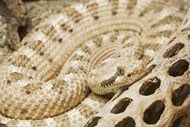Sidewinder
Found from southeastern California barely into Utah and south to southwestern Arizona and northwestern Mexico.
Widely known because of the erect scales over its eyes and distinctive sidewinding movement across loose sand, this little rattlesnake can be difficult to adapt to the terrarium. Wild-caught specimens are notorious for heavy parasite loads and must be wormed by a qualified veterinarian and checked for other types of parasites. Additionally, they are subject to blister disease due to humidity in the terrarium. A 20-gallon terrarium with excellent ventilation works well. The substrate should be dry sand or anything similar that will not hold moisture. Give a small bowl of water once every two or three weeksâ”the snakes get their water from their food and donât normally drink, but a spill can cause serious problems. The temperature should be maintained between 80 and 90 degrees Fahrenheit, with an undertank heating pad and a basking lamp.
Feeding is often a problem. In nature the sidewinder takes a variety of lizards and small rodents, but in the terrarium it often demands lizards. Mediterranean geckos (Hemidactylus turcicus) have proven acceptable and easy to obtain; they should be fed after being frozen and thawed to reduce infectious parasites. Sidewinders often can be tricked into taking small mice by placing a baby gecko or a gecko tail in the mouth of the mouse.
Though not considered deadly, the bite of this species is dangerous and damaging and it also is a speedy snake, so precautions should be taken at all times.

